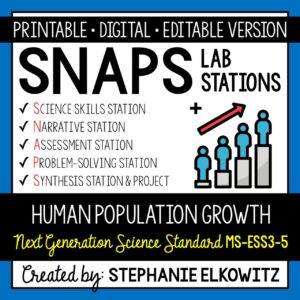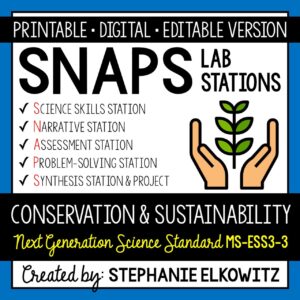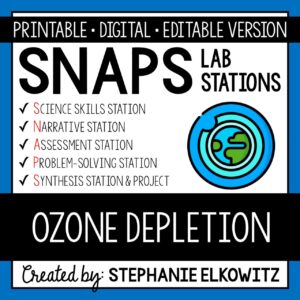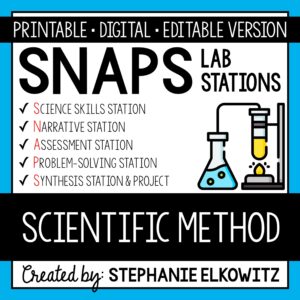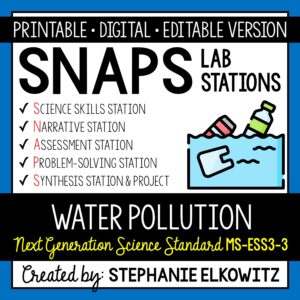Hydrophobic vs. Hydrophilic Lab
$7.00
An engaging lab activity designed to enhance students’ understanding of the difference between hydrophobic and hydrophilic substances.
Description
Hydrophobic vs. Hydrophilic Lab Preview
SNAPs Lab Stations Activities require students to use science, math, literacy, problem-solving and engineering skills. They are designed to enhance students’ understanding of scientific concepts and help students apply scientific ideas to the real world. Each station activity promotes skills so to develop students into proficient and competent scientific thinkers.
SNAPs lab activities have five components:
• Science Skills Station to develop science skill proficiency
• Narrative Station to build science literacy
• Assessment Station to evaluate learning and understanding
• Problem-Solving Station to foster engineering design
• Synthesis Station and Project to inspire higher-order learning
DIGITAL LABORATORY – DISTANCE LEARNING & DIGITAL CLASSROOMS
• This lab is offered in a digital format to support digital classrooms & distance learning.
• The digital lab activity is designed to work with Google Slides and Microsoft PowerPoint
• The digital lab activity CANNOT be edited. However:
– Students can manipulate text boxes
– Students can create tables, graphs and diagrams
– Students can insert images and drawings
GOOGLE FORM ASSESSMENT STATION
• The assessment station is offered as a self-grading Google Form.
• Questions are all short answer and are 100% editable.
• Suggestions for use are included in the download.
DISTANCE LEARNING COMPATIBILITY
SNAPs lab activities are rated for their ease with distance – independent learning. Refer to the preview for more information about how well this laboratory works in a fully digital classroom and with distance learning.
EDITABLE DOCUMENTS
This download includes an editable word document (docx file) of all lab components:
• Pre-Lab and Post-Lab Activities
• The Lab Overview
• Lab Station Activities and Questions
• Directed Synthesis Project (when applicable)
Important Notes:
• Diagrams, illustrations, tables and graphs essential to lab activities are included
• Illustrative clipart is NOT included
• Editable documents and rubrics are included with the FREE SNAPs Setup Guide
Editable files allow you to:
• Edit the scope of the activities so to suit your students’ needs
• Edit the materials required based on resource availability
• Create single-period “mini-labs” using activities at the individual skills stations
The activities at each station in this lab are detailed below.
Hydrophobic vs. Hydrophilic Stations Activity Learning Objectives
1. Discuss water as an important and common solvent.
2. Compare hydrophobic and hydrophilic substances.
3. Explain why polar substances and salts dissolve in water but nonpolar substances do not.
4. Demonstrate and evaluate the use of emulsifiers.
Science Skills Station
Students will study hydrophobic and hydrophilic substances at this station. They will determine whether common substances are hydrophobic or hydrophilic and make predictions about the chemical makeup of the substances.
Narrative Station
Students will read an informative text about water as a solvent. They will read about how we classify substances that dissolve or mix with water and others that do not. Students will also read about how polarity impacts the ability of a substance to mix or not mix with water.
Assessment Station
At this station, students will answer questions about key terms and ideas relating to hydrophobic and hydrophilic. Students must employ lower, mid and higher order thinking skills to answer these questions.
Problem-Solving Station
Students will model how engineers make a hydrophobic substance mix with water. They will model the use of soap and egg yolks as emulsifiers to make water and oil mix together. Students will evaluate how these emulsifiers are used in a variety of mixtures. They will also study how engineers try to make more efficient emulsifiers.
Synthesis Station
Students will compose a CER (claim-evidence-reasoning) report to summarize the lab. Students are provided the claim statement and must support the claim with observations, data and other information gathered in the lab. Students will explain how the evidence supports the claim using scientific reasoning.
Synthesis Project
Students will have a choice of 11 projects. Refer to the SNAPs Lab Stations Best Practices and Setup Guide for directions and suggestions on how to conduct the project.
This download includes:
• A pre-lab assignment and post-lab reflection
• Directions and questions for each lab station
• Student recording sheets
• Teacher Key
Additional Materials Required:
Water
Rubbing Alcohol
Vegetable Oli
Vinegar
Butter
Corn Syrup
Salt
Egg (1 per group)
Dish soap
8 250 mL-beakers or clear plastic cups
2 100 mL Graduated Cylinder
Tablespoon measuring device
2 Stirring rods
1 small bowl
1 Spoon
1 Computer or tablet
LINKS TO VIDEOS
This laboratory requires internet to access videos. Videos are hosted on SafeShare.TV so to safely watch and share educational YouTube videos without ads, comments and other distractions. Shortened and full link(s) to SafeShare.TV included. Full link to original YouTube video(s) included.
NEXT GENERATION SCIENCE STANDARDS
This laboratory does not address a specific Next Generation Science Standard, but it complements NGSS concepts. It combines the three dimensions of science learning – science and engineering practices, disciplinary core ideas and crosscutting concepts – in order to meet the standard. This laboratory also makes interdisciplinary connections to STEM, Math CCSS and ELA CCSS to build the appropriate skills.
TERMS OF USE
• All rights reserved by Stephanie Elkowitz.
• This product is to be used by the original purchaser only.
• Intended for classroom and personal use only.
• Copying for more than one teacher, classroom, department, school, or school system is prohibited.
• This product may not be distributed or displayed digitally for public view.
• Failure to comply is a copyright infringement and a violation of the Digital Millennium Copyright Act (DMCA).




